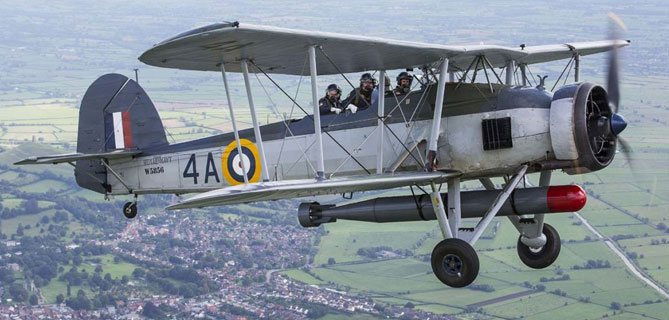
As an impressionable young school-kid I didn't understand the stupidity of wars, the loss of life and hard-ships endured. I just saw the glamour, the technology and the heroic battles against all odds.
I had the airfix models, Bismarck, HMS Hood and even had a fairey swordfish dangling from my bedroom ceiling.
Bismarck was the 1940's equivalent of Deathstar. The most advanced Battleship of it's time with a displacement of 50,000 tons, 2,000 crew, over 800 foot in length with an armament of 68 guns from 2" flak up to their main battery, which had, 8 x 15" diameter guns that could accurately throw an 1800lb shell 22 miles.
Bismarck had battle damage from it's previous engagement, when it sunk the H.M.S. Hood, and was heading for repairs at Brest. We couldn't allow that to happen, she was too dangerous to our shipping, but we had no heavy ships near enough to stop her.
The turning point in the final battle of the Bismarck, was the second attack by the Fairey swordfish. This damaged the rudder enough to slow her down and allow the pursuing boats to catch up. The swordfish was a 1930's biplane, capable of carrying one torpedo and nicknamed the Stringbag. There was a sixty miles an hour wind blowing.
OK you gotta be wondering where I am going with this story.
The 4th flight, 820sqn, aircraft number 4A pilot was Lt. Hugh de Graaff Hunter, M.I.D., RN, he led his flight in from the port side,(if I can quote a bit from kbismarck.com).. "The third and fourth sub flights managed to stay together in the descent until they hit 2,000 feet, then they separated. As they cleared the clouds, Lieutenant H. de G. Hunter (4A), and Sub-Lieutenants(A) M. J. Lithgow (4B), F. A. Swanton (4C), and C. M. Jewell (2M) reformed in a clear patch of sky as they popped out of the underside of the cloud layer, and forged in from the port side at the same time as the second sub-flight came in from starboard. The German flak was extremely accurate, and followed them until they were seven miles from the target. Bismarck’s gunners seemed to be particularly attentive to 4C, which tallied no less than 175 holes in it. Both the pilot, Sub-Lieutenant(A) Swanton and his TAG, Leading Airman J. R. Seager were wounded, while the observer, Sub-Lieutenant(A) G. A. Woods weathered the storm unscathed."
The Admiralty released a supplement to the London Gazette
ADMIRALTY
Whitehall
16th September, 1941
The KING has been graciously pleased to give orders for the following Appointments to the Distinguished Service Order, and to approve
the following Awards to Officers and Men of H M Aircraft-Garners and Naval Air Stations for gallantry, daring and skill in the operations
in which the German Battleship Bismarck was destroyed
among eight named recipients was:
The Distinguished Service Cross to Lieutenant Hugh de Graaff Hunter, Royal Navy, H M S Ark Royal
Hugh's family actually came from Fife. Hugh's grandad, James Cuthbertson Manderson Hunter was born around 1845.
At the age of 14 he went to Edinburgh where he got a job at a Seed Merchants, he improved his education at night school.
He moved down to Chester in England and joined Dickson's Seed Merchants. In 1874 he married Sarah Jane Pierrepont and they started a family. At the age of 38, in 1883, James Hunter started in business for himself with a farm seed business called, Hunter's of Chester, which is still in operation today, run by his grandson Peter Hunter.
One of James's three sons was named James De Graaff Hunter born in 1882. The De Graaff part was named after the sons godfather, a dutch bulb grower, friend and colleague of the father. James De Graaff Hunter was a mathematics genius and achieved world wide fame in the science of Geodetic's. Dr James De Graaff Hunter C.I.E., Sc.D., F.R.S., was in 1928 appointed Director of the Geodetic Branch.
{ I will add more on this James, who had a colourful life and the rest of the family another time, for now it's Hugh's page. }
Hugh De Graaff Hunter was born in 1916 son of Dr. James De Graaff Hunter. He served, as mentioned in 820 Squadron early on in the war, essentially ship based, his land base was H.M.S. Jackdaw, in Fife. He would have had a married quarters there, when service permitting, he could snatch some time with his wife Hazel
About 20 miles up the coast from me is the village of Crail, in the East Neuk of Fife. Known mainly for it's picturesque harbour. Another claim to fame is an old airfield used in the last two world wars, which closed down in 1960's and due to it's protected status, is still standing though showing it's age. It is used for all sorts of "car meets", boot sales and air related sports.
I know Crail well, we used to have a small boat and the slipway in the harbour was handy for launching, and that old airfield fascinates me.
We wandered once through Crail Cemetery a couple of years ago and were surprised at the amount of war graves there. One that raised my curiosity was of a Hunter with a Dutch name, duly noted at that time, and added to my 10,000 Hunter things to find out about before I die ..
Lieutenant(A) Hugh de Graaff Hunter, D.S.C., R.N.
Well that time is now, been putting the story together, still not finished, but enough for now ...
Oh Hugh, I feel like I know you.
After the Bismarck the squadron headed for Iceland and changed ship from the HMS Ark Royal to the HMS Victorious. The Fairey Swordfish were getting replaced by the newer Fairey Albacore and Hugh was sent back to Crail for conversion training.
On 5 November 1942, at the age of 26, Hugh's luck ran out.
